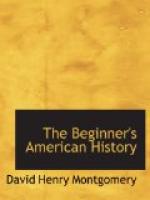[Footnote 9: Palos (Pa’los); see map in paragraph 12.]
[Footnote 10: Convent: a house in which a number of people live who devote themselves to a religious life.]
[Footnote 11: Isabella (Iz-ah-bel’ah).]
7. Columbus gets help for his great voyage.—Columbus left his son at the convent, and set forward on his journey full of bright hopes. But Ferdinand and Isabella could not then see him; and after waiting a long time, the traveller was told that he might go before a number of learned men and tell them about his proposed voyage across the Atlantic.
After hearing what Columbus had to say, these men thought that it would be foolish to spend money in trying to reach the other side of the ocean.
People who heard what this captain from Lisbon wanted to do began to think that he had lost his reason, and the boys in the streets laughed at him and called him crazy. Columbus waited for help seven years; he then made up his mind that he would wait no longer. Just as he was about leaving Spain, Queen Isabella, who had always felt interested in the brave sailor, resolved to aid him. Two rich sea-captains who lived in Palos also decided to take part in the voyage. With the assistance which Columbus now got he was able to fit out three small vessels. He went in the largest of the vessels—the only one which had an entire deck—as admiral[12] or commander of the fleet.
[Footnote 12: Admiral (ad’mi-ral).]
8. Columbus sails.—Early on Friday morning, August 3d, 1492, Columbus started from Palos to attempt to cross that ocean which men then called the “Sea of Darkness,”—a name which showed how little they knew of it, and how much they dreaded it.
We may be pretty sure that the guardian of the convent was one of those who watched the sailing of the little fleet. From the upper windows of the convent he could plainly see the vessels as they left the harbor of Palos.
[Illustration: Columbus leaving Palos, August 3D, 1492.]
9. What happened on the first part of the voyage.—Columbus sailed first for the Canary Islands, because from there it would be a straight line, as he thought, across to Japan and Asia. He was obliged to stop at the Canaries[13] more than three weeks, in order to make a new rudder for one of his vessels and to alter the sails of another.
At length all was ready, and he again set out on his voyage toward the west. When the sailors got so far out on the ocean that they could no longer see any of the islands, they were overcome with fear. They made up their minds that they should never be able to get back to Palos again. They were rough men, used to the sea, but now they bowed down their heads and cried like children. Columbus had hard work to quiet their fears and to encourage them to go forward with the voyage which they already wanted to give up.
[Footnote 13: Canaries (Ka-na’rez); see map in paragraph 12.]




